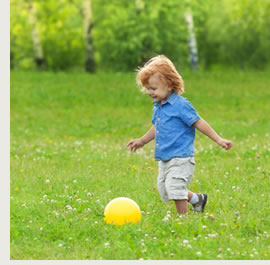|
|
|||||
|
|||||
| Let's get moving | |||||
|
In addition Quality Area 2 (Children's Health and Safety) of the National Quality Framework requires child care providers to explicitly address physical activity by embedding it in the program and promoting it through planned and spontaneous learning experiences. There are many advantages to encouraging physical activity in kids and ensuring young children have plenty of opportunities to get moving sets a great foundation for later life and instils confidence and self esteem. Some of the other benefits of being active include:
Australia’s National Physical Activity Recommendations support the presence of large amounts of physical activity in the early childhood setting. The guidelines suggest that infants (birth to 12 months) should be allowed to engage in supervised floor-based play from birth while toddlers (12 months to three years) and preschoolers (three to five years) should be physically active for a minimum of three hours across a day. The guidelines also recommend that infants, toddlers and preschoolers should not be sedentary, restrained or kept inactive for more than one hour at a time, with the exception of sleeping. In addition the guidelines specify that children younger than two should not spend any time watch TV or using electronic media while children aged two-five should have less than one hour of screen time per day. It’s important to note that because a child is energetic doesn’t necessarily mean that he or she is physically fit. While a physically energetic kid may have a lean body composition they may still be weak in cardiovascular endurance, flexibility and muscular strength. To ensure children develop these attributes early childhood services should offer kids a wider variety of structured and spontaneous play based physical learning experiences that link to their interests and abilities. For spontaneous/free play activities simply allow the children to choose or make up activities using their bodies, the physical environment and the available equipment. Besides offering many physical benefits, free play allows children to participate without the pressure to perform; the children set their own goals and determine their own activities. This approach encourages shy children to try new things without the pressure of peers while benefiting the active learner who has an innate need to learn by doing. To make the most of the space and keep children interested regularly change the equipment available to them. Some examples of unstructured play include dancing, running around in the playground and digging in a sand pit. In structured play or circle time, guide the children in an activity you wish to teach them or for them to follow. The success of these activities is to some extent determined by the creativity, enthusiasm and involvement of the early childhood educator running the activity. To ensure you choose the right activities at the right level consider the following guidelines:
Some examples of structured play include action songs and action games such as What’s the Time Mr Wolf? And Simon Says. A good way for early childhood education and care providers to successfully incorporate physical movement is to develop a physical activity policy covering the scope of the service’s objectives and how it will achieve those objectives. The policy should cover the service’s approach to structured and unstructured physical activity as well as how it will work to improve children’s fundamental movement skills, the gross motor movements which involve coordination of different body parts and provide the foundation skills necessary to participate in sports, games and other recreational activities. Your service policy on physical activity should also address sedentary activities and screen time. References: Bringing Fitness to your Classroom: The Fitness Learning Center by Anna Gammal Healthy Kids an initiative of the NSW Government. |
|||||
|
Do you have interesting ways of getting kids moving?
Share your tips below
comments powered by Disqus
|
|
|||||||||

 Physical activity is crucial for the healthy development of kids and early childhood education and care services are well placed to promote physical activity and wellbeing.
Physical activity is crucial for the healthy development of kids and early childhood education and care services are well placed to promote physical activity and wellbeing.